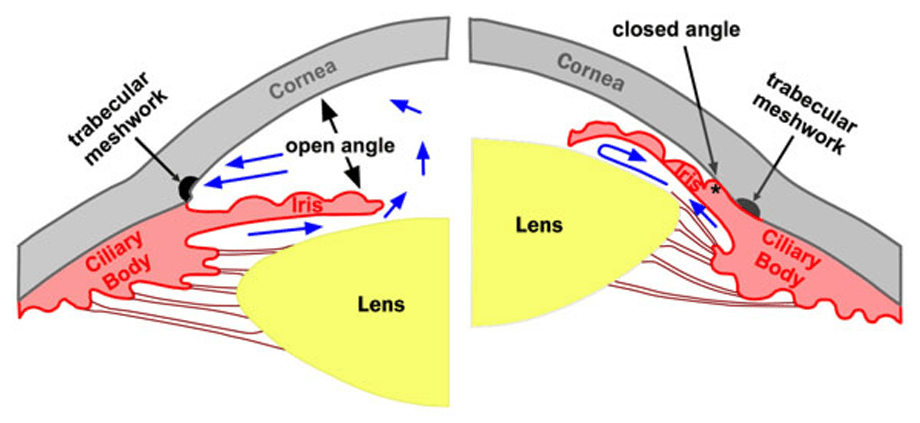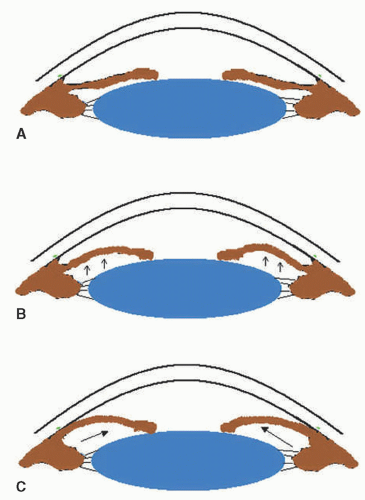Understanding narrow angle glaucoma
In narrow angle glaucoma the natural drainage of the eye suddenly closes potentially causing rapid decrease of vision. The angle between the underside of cornea and top side of iris becomes narrow or closes. In narrow angle or closed angle the angle becomes narrow or sometimes appears to be closed that does not let the aqueous humor to reach the trabecular meshwork properly for its drainage. Glaucoma is the diseases of the optic nerve in association with elevated intra-ocular pressure of the eye.

In case of open angle glaucoma the fluid reaches to the trabecular meshwork and the problem is actually in the it which interferes in the normal drainage of the.
The ciliary body produces aqueous humor which makes the intra-ocular pressure of the eye.
Asymptomatic
Narrow angle glaucoma is generally asymptomatic. It can only be diagnosed if the people regularly meet their ophthalmologists and their angle evaluation takes place. The tests for its confirmation are OCT and Gonioscopy exams. With the passage of time the narrow angle decreases.
Causes of narrow angle glaucoma
Plateau iris syndrome
It occurs due to abnormal ciliary body. The ciliary body holds the iris upward i.e. towards the trabecular meshwork causing narrow angle. It is generally asymptomatic unless angle closure glaucoma occurs. The eye pressure increases.

Hyperopia- refractive error
Hyperopia is the type of refractive error in which a person faces difficulty in seeing near objects clearly with naked eye. The size of the eyeball of hyperopic person is smaller than the normal biological variations. Due to this, the anterior chamber of the eye is shallow. This causes a predisposition for narrow angle glaucoma.
Other symptoms
The diseases of retina, ciliary body mainly intermediate uveitis or other types of swelling can lead to angle closure glaucoma.
Risk factors
It is far more common in Asian countries and most common in China
Females are four times more vulnerable
Increasing age
Shallow anterior chamber
Cataracts
Trauma or secondary to other eye disease
Family history
Most common types
Chronic angle closure
It is the gradual development of angle closure glaucoma due to constant and gradual narrowing of the angle. It generally does not have symptoms to diagnose its occurrence.
Causes
Family history of angle closure glaucoma
History of surgery or trauma
Diabetes mellitus
Symptoms
It is aymptomatic and the patients even have normal visual acuity
Clinical signs
Damage to optic nerve head
Increase intra-ocular pressure
Visual field loss
Diagnosis
Different diagnostic tests that help in the diagnosis of them are Gonioscopy, tonometry, perimetry and OCT (optical coherence tomography) Its treatment include medications, surgical and laser treatment.

Acute angle closure
It is the sudden onset of angle closure glaucoma. The ciliary body keeps on producing aqueous humor which also plays role in closing of the angle of the eye. This keeps on elevating the IOP of the eye. It has a general range of 12 to 20 mmHg. But in acute angle closure it can go in 50s, 60s and in 70s with in hour. The highest recorded IOP is in 80s mmHg.
When the IOP increases above 50mmHg it can damage the blood supply and optic nerve of the eye as well. it can cut off the blood supply and it is a medical emergency because the damage can lead to permanent vision loss
Symptoms
Blurred vision
Red eye
Pain in eye
Seeing halos around light
Headaches
Nausea and vomiting
Treatment
Laser peripheral iridotomy
Surgery by making a hole in iris to make a passage for the aqueous humor to reach to trabecular meshwork to get its drainage.
Avoid using medications which have a warning of causing narrow angle e.g. anti-nausea seasick medications and allergy medications for cold flu
Founder of EyesMatterMost- an optometry student who loves talking about eyes. I tend to cover topics related to optometry, ophthalmology, eye health, eyecare, eye cosmetics and everything in between. This website is a medium to educate my readers everything related to eyes.
